Winter is a fantastic season with white sceneries and joyous outdoor activities from ice skating, skiing, and snowballing to snowmobiling. While these activities are fun, they can strain your muscles, leading to injuries that can aggregate your back pain, making it not the best season for folks with back pain.
Acute back soreness, stiff joints, and muscle strain are a few unfavorable side effects that might result or worsen from engaging in intense winter activities and chores. Nevertheless, below is everything you need to know about winter and back pain.

Winter Activities that Worsen Back Pain
Winter Activities that can Worsen Back pain
Different activities in winter increase your risk of back pain. Here are some of these activities:
- Cleaning Your House
Deep cleaning during winter includes bending, scrubbing, lifting, and scooping, which can strain your back. Sometimes, you experience a pulled muscle when cleaning and do not realize it. As you continue cleaning, the muscles worsen, causing back pain.
- Shoveling
If you are not careful when shoveling snow off your driveway or walkways, it could cause more back pain. Heavy lifting and bending required for this task could strain the back muscles and result in more back discomfort.
- Winter Sports
Winter sports such as snowboarding and skiing can cause back pain. The heavy boots and skis can pressure the lower back, causing pain. Falling while skiing or snowboarding can also stress the spine and soft tissues around it, leading to more back pain.
How Cold Weather and Winter Activities can Worsen Back Pain
The cold winter weather worsens back pain through a process known as vasoconstriction. This occurs when blood vessels narrow down and divert the extra blood to vital organs such as the lungs, heart, and brain. This results in less blood flow in the tendons, ligaments, muscles, and spine.
Low blood flow in the spine causes it to become stiff and tight. It strains your back and pulls on sensitive nerves causing back pain. Engaging in strenuous activities such as gardening and cleaning during this time causes more pressure in the back, worsening your back pain.
How You Can Prevent Back Pain
You can prevent winter back pain in various ways. Here are some tips:
- Wear the Right Gear
When you’re outside, dress in several layers, preferably in comfortable, move-friendly clothing and equipment. The appropriate shoes will help protect you against accidents that could cause or worsen your back discomfort, such as falls, slips, and other mishaps.
- A Healthy Diet
A balanced diet rich in calcium and healthy minerals helps prevent back pain. Calcium is not only good for the bones but also the spine. Minerals such as magnesium are good muscle relaxants that help prevent back pain during cold weather.
- Exercise Your Body
Staying physically active relaxes your muscles and increases mobility. Reduced stiffness allows easy movement and flexibility even during the winter, preventing back pain.
Treatment Options for Winter Back Pain
There are different treatment options for winter-related back pain. Here are some treatment options:
- Cold therapy
The use of cold therapy is a highly effective treatment for various physical ailments, including back pain, swelling, and muscle strains. There are many ways to apply it, such as ice massages, coolant sprays, ice packs, and ice baths. These are among the easiest, most effective treatments for reducing back pain and swelling.
- Heat therapy
Steamed towels, hot baths, and moist heating packs effectively reduce back pain. They offer temporary back relief by relieving tension and stiffness in the back.
- Interventional procedures and therapies
Pain procedures such as injections and medications are effective in treating back pain. Therapies such as acupuncture, chiropractic services, and physical therapy also help relieve back tension and treat back pain.
Get Treatment for Pain
If you are experiencing winter back pain, you should seek professional help as soon as possible before it worsens. At Progressive Pain Management, we focus on interventional effective pain procedures and advanced therapies to relieve back pain. Contact us today or fill out the form below to request an appointment.
Do you experience pain when you stand up out of a chair? Do you feel a dull or sharp pain in your lower back? You may be experiencing Sacroiliac Joint (SI) pain. This condition is very common – in fact, 15-30% of people who suffer from this kind of pain have joint problems they may not know about.
The good news is that numerous treatments are available to relieve you of this pain. But what is the SI Joint? And what causes this kind of pain?
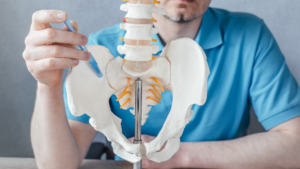
Sacroiliac Joint Pain Causes and Treatment
What is the Sacroiliac Joint?
The sacroiliac joints are in your lower back, sitting on both sides of your spine. Their main job is to carry the weight of your upper body when you stand, walk, or shift your weight to your legs.
Although the pain typically starts in your lower back, if often moves to your buttocks, thighs, or upper back.
Causes of Sacroiliac Joint Pain
Because the SI joints carry the weight of your upper body, there are multiple causes for why you experience pain.
- Traumatic Injury – An injury like a fall or being in a car accident are common reasons for having SI joint pain. The force from this kind of injury strains the ligaments around the joint. If the ligaments aren’t treated correctly, they can tear and loosen the SI joints. When the joints move around too much from being loose, the SI joint can cause chronic pain.
- Arthritis – A specific kind of arthritis called ankylosing spondylitis affects the spine. It causes pain in your hips and buttocks.
- Pregnancy – Women have a higher chance of experiencing SI joint pain during pregnancy and childbirth. The same hormones that prepare the pelvis for childbirth loosen ligaments around the SI joint. This causes aches and pains that are common in pregnancy. The added weight during pregnancy also affects your SI joint.
Symptoms of Sacroiliac Joint Pain
SI joint pain can be hard to tell apart from other types of lower back pain. Because the pain can spread to your upper back, thighs, and buttocks, the pain could be confused with other conditions.
The main symptoms to look for are:
- Lower back pain
- Thigh pain
- Discomfort and pain after sitting
- Hip/Buttocks pain
It’s common to have after sitting for a long time, but SI joint pain also happens after running, climbing stairs, or taking large strides.
Diagnosing Sacroiliac Joint Pain
SI joint pain can disguise itself as different types of pain, like a herniated disc or facet joint arthritis. Doctors perform a series of tests to determine if you are suffering from SI Joint Syndrome. Pain during these tests helps the doctors learn more about where the pain is coming from.
Tests might include a variety of physical tests where the doctor will put stress and pressure on the joint to see if there is soreness or tenderness.
Doctors may also order diagnostic tests to confirm the source of your pain. These tests are often joint injections to confirm the root of your pain and imaging like X-Rays or MRIs to see a detailed image of soft tissue and bone.
Treatment Options for SI Joint Syndrome
Treatments for SI joint pain focus on reducing pain and restoring the full range of motion in the joint. Pain is treatment with non-surgical options, only using surgery if the pain persists.
Common treatments are:
- SI Joint Injections – Cortisone injections are used to reduce pain and calm inflammation. They can relieve pain for several weeks or months.
- Physical Therapy – Physical therapists create a specific program focused on your pain and discomfort. Their goal is to help you restore your quality of life, get back to doing your favorite activities, and manage your pain daily. Physical therapy trains your body to strengthen the ligaments and joints.
- Pelvic Brace – A supportive brace is helpful if your SI joint is loose. Wearing a brace that tight helps reduce inflammation and supports your painful joints.
- Heat or Ice – This at-home pain reliever is a great way to temporarily reduce pain, tensions, and inflammation to the joint.
Doctors may recommend multiple treatment options until they find a combination that works for your pain. Pain is different for everyone, so it’s important to find a doctor who creates an individualized treatment that fits your needs and lifestyle.
The team at Progressive Pain Management can help you reduce SI Joint Pain in a way that fits your lifestyle. Fill out the form below to get in touch with our team today.
Cognitive Behavioral Therapy is a treatment approach that combines techniques to help people identify and correct faulty patterns of thoughts, feelings, and behaviors. The goal is to increase function and reduce pain.
A Brief History
Cognitive Behavioral Therapy was developed in the mid-1970s by Dr. John Sarno, a clinical professor of rehabilitation medicine at New York University School of Medicine. It is based on his belief that most lower back pain results from unconscious emotional factors, particularly feelings of stress and anxiety in the muscles of the lower back and abdomen.
According to Dr. Sarno, when people unconsciously repress feelings or emotions they often experience physical symptoms in the body as a consequence of the unconscious mind acting to protect them in some way.
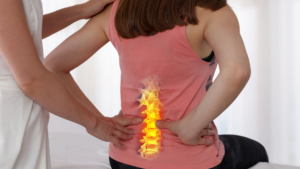
Treating Low Back Pain with CBT
He believes that most people who develop lower back pain have repressed anger toward someone else or themselves, which he calls ‘core beliefs’. Core beliefs are often formed in childhood and are the result of unresolved emotional conflicts. The pain creates fear, further suppressing emotions, resulting in a vicious cycle.
Dr. Sarno’s approach focuses on getting patients to become aware of these unconscious emotions and how they affect their physical well-being through persistent pain. He teaches people to reinterpret the pain in a positive way, as a sign that they can now initiate the healing process.
How Cognitive Behavioral Therapy Works
Cognitive Behavioral Therapy takes place in six to eight weekly sessions, each lasting an hour. The first session is about education and explaining how pain might develop. The remaining sessions are spent discussing memories in the patient’s life that may be linked to the pain, identifying repressed emotions, and working out strategies to deal with them.
The interactive sessions aim to help patients become aware of patterns that can trigger their pain, such as poor time management or expectations set too high by family members. They also explore how a patient’s thoughts and emotions affect the sensations in the lower back. A key part of Cognitive Behavioral Therapy is becoming aware of ‘early warning signs’ so they can be acted upon before pain becomes a problem.
Cognitive Behavioral Therapy for Lower Back Pain focuses on the mind-body connection and how emotions affect physical health, partially through stress hormones such as cortisol, which have been linked to chronic pain.
The Approach’s Value
In some cases, Cognitive Behavioral Therapy for Lower Back Pain permanently reduces or eliminates pain. In one study, 78% of people with chronic lower back pain reported that treatment was successful and they were able to return to work.
A review of research found that the approach was effective for chronic lower back pain, but not acute low back pain. In addition to treatment sessions, Cognitive Behavioral Therapy for Lower Back Pain encourages people with lower back pain to keep a daily diary. This helps them become more aware of their thoughts and behavior patterns that may be contributing to or exacerbating the pain.
When to Seek Cognitive Behavioral Therapy for Lower Back Pain
People who meet the following criteria would likely benefit from Cognitive Behavioral Therapy for Lower Back Pain:
- Have experienced pain in their lower back at least once a day for the previous three months.
- Have been unable to take medication or engage in physical therapy because it hasn’t worked for them in the past.
- Do not have a severe, progressive illness that could be causing their lower back pain.
Patients with the most severe pain and functional disabilities may need additional medication, acupuncture, and physical therapy.
Final Thoughts
Chronic lower back pain is a prevalent and costly condition. People with chronic lower back pain must receive effective treatment that focuses on self-management or self-care measures.
Cognitive Behavioral Therapy for Lower Back Pain may be an effective intervention for this group of people. Still, the approach works best when both patient and therapist are committed to participating in all sessions without exceptions.
If you suffer from chronic back pain and want to learn more about this approach, contact Progressive Pain Management to discuss your treatment options.
Spinal cord stimulation (SCS) has emerged as a transformative approach to managing chronic pain conditions that have proved resistant to traditional therapies. This article delves into the groundbreaking field of SCS, shedding light on its mechanisms, applications, and potential to revolutionize pain management.
Chronic pain conditions represent a significant healthcare challenge, affecting millions of individuals worldwide. When conventional treatments fail, spinal cord stimulation (SCS) offers a promising alternative. This innovative approach has shown considerable efficacy in managing refractory chronic pain conditions, providing relief and improving the quality of life for many patients.
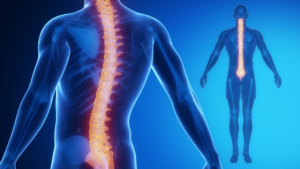
Spinal cord stimulation as a revolutionary approach to pain management
Understanding Spinal Cord Stimulation
SCS involves the delivery of low-level electrical pulses to the spinal cord, interfering with the transmission of pain signals to the brain. This process effectively ‘masks’ pain signals, replacing them with a tingling sensation known as paresthesia.
The Evolution of Spinal Cord Stimulation
The concept of SCS can be traced back to the 1960s, with the introduction of the Gate Control Theory of pain by Melzack and Wall. This theory proposed that non-painful input closes the ‘gates’ to painful input, preventing pain sensation from traveling to the central nervous system. This theory laid the foundation for the development of SCS.
Mechanism of Action
SCS works by modulating the pain signals at the spinal level, before they reach the brain. The electrical pulses delivered by the stimulator compete with the pain signals, effectively ‘drowning them out’ and preventing them from reaching the brain.
Applications of SCS
SCS has been successfully employed in managing various chronic pain conditions, such as:
- Failed Back Surgery Syndrome (FBSS)
- Complex Regional Pain Syndrome (CRPS)
- Ischemic and coronary artery disease
Benefits of SCS
SCS offers numerous advantages over traditional pain management therapies. These include:
- Effectiveness: SCS has shown considerable efficacy in reducing pain intensity and improving the quality of life for patients with refractory chronic pain conditions.
- Customizability: The stimulation parameters can be adjusted to meet the individual needs of each patient, ensuring optimal pain relief.
- Cost-effectiveness: Despite the high initial cost, SCS can be a cost-effective solution in the long run, especially when compared with other long-term therapies.
Challenges and Limitations
While SCS offers numerous benefits, it is not without its limitations. These include the invasive nature of the procedure, potential for complications, and the requirement for ongoing management and adjustment of the stimulator settings.
Advancements in Spinal Cord Stimulation Technology
Over the years, significant advancements have been made in SCS technology. Modern devices are more sophisticated and reliable, offering improved pain relief and fewer complications.
The Future of Spinal Cord Stimulation
The field of SCS is evolving rapidly, with ongoing research and development paving the way for more effective and safer solutions for chronic pain management.
Conclusion
In conclusion, SCS represents a revolutionary approach to chronic pain management. By modulating pain signals at the spinal level, SCS offers a promising alternative for patients who have not found relief through conventional therapies. As research and technology continue to advance, the future of SCS looks promising, offering hope for millions of individuals living with chronic pain. Talk to the professionals at Progressive Pain Management to learn more about spinal cord stimulation therapy and if this treatment is effective for your chronic pain. Fill out the form below to get started.
Do you or a loved one experience chronic pain, limited mobility, and decreased quality of life even after undergoing back surgery? If so, there may be a condition called Failed Back Surgery Syndrome (FBSS) at play. FBSS is a common complication for people who have undergone various types of spine surgery for various spinal disorders.
While this difficult-to-treat syndrome typically occurs after lumbar spine surgery, it can also occur in the cervical and thoracic regions as well. Read on as we analyze the causes, symptoms, diagnosis, and treatment approaches available for patients affected by FBSS to help clarify this frustrating condition.
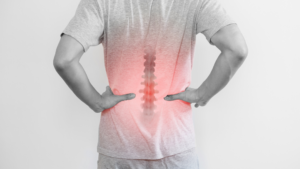
Failed Back Surgery Syndrome
fWhat is Failed Back Surgery Syndrome?
Failed back surgery syndrome occurs when patients experience persistent pain after undergoing spinal surgery. This pain can range from mild to severe and can be located in the same area where the pre-existing pain was before the surgery or even in an entirely new area. It is estimated that between 7% and 27% of all spinal surgeries result in failed back surgery syndrome.
Symptoms of Failed Back Surgery Syndrome
The symptoms of FBSS can vary widely, depending on the severity and location of the pain. Commonly reported symptoms include:
- Persistent back or leg pain
- Limited mobility or difficulty walking
- Numbness in the feet or legs
- Problems with bladder or bowel control
What Causes FBSS?
Failed back surgery syndrome can occur due to a variety of reasons, including scar tissue formation around the surgical site, nerve damage caused by the surgery itself, or undiagnosed underlying conditions that were not addressed during the original operation. Whatever the cause may be, it is essential to know that there are treatment options available to help manage your symptoms and reduce your pain.
Diagnosing Failed Back Surgery Syndrome
To diagnose FBSS, your doctor will ask about the history of your back pain and take a physical examination to assess any spinal instability. They may also use imaging studies such as an x-ray, CAT scan, or MRI to get an idea of what is going on in the spine. Other tests, such as an electromyogram (EMG) or nerve conduction study, may be done to measure how well your nerves are working.
Treatment Options for Failed Back Surgery Syndrome
There are several treatment options available for those suffering from FBSS, including:
- Physical Therapy – Physical therapy is often recommended as one of the first steps in treating FBSS. It focuses on strengthening weak muscles, increasing flexibility, improving posture, and teaching proper body mechanics to help reduce pain levels over time.
- Medication – Your doctor may prescribe pain medications as part of your treatment plan for FBSS, including non-steroidal anti-inflammatory drugs (NSAIDs), muscle relaxants, or opioid medications such as oxycodone or hydrocodone. Your doctor will determine which medication(s) best suits your individual needs.
- Psychological Therapy – Cognitive behavioral therapy (CBT) is beneficial in treating chronic pain conditions such as FBSS. CBT helps patients develop healthy coping skills to deal with their pain more effectively and learn how to better manage stress levels.
- Spinal Cord Stimulation – Spinal cord stimulation (SCS) involves using electrical signals delivered through implanted electrodes placed near nerves within the spinal cord that have been identified as being involved with the patient’s chronic pain condition. SCS works by blocking or decreasing nerve signals associated with pain from reaching the brain.
- Alternative Treatments: In addition to traditional treatments such as medications and physical therapy, alternative treatments may be useful in treating FBSS symptoms. These include acupuncture, chiropractic care, yoga/meditation techniques, biofeedback training (a technique used to teach the body how to control its responses), and hypnosis techniques (which may help patients learn how to better cope with their chronic pain). While these alternative treatments cannot completely cure FBSS, they may provide additional relief when combined with traditional treatments like medications or physical therapy.
Get the Help you Need!
Failed back surgery syndrome (FBSS) is a very real phenomenon that can happen to anyone who has had spine surgery. FBSS often leads to chronic pain and can be extremely difficult to manage. If you or someone you love is struggling with FBSS, know that help is available. At Progressive Pain Management, we specialize in treating patients with FBSS and other complex cases of chronic pain.
We offer a wide range of treatments, from medication management to interventional procedures, and our team will work with you to create a customized treatment plan that fits your needs. Please fill out the form below to contact us today to learn more about how we can help you find relief from your chronic pain.
Chronic pain affects millions of Americans each year. Back pain is not only uncomfortable, but it can be debilitating and cause damage to other parts of the body. Living with back pain interferes with the quality of life on a regular basis and can be incredibly limiting.
Back pain can be acute or chronic, and many factors determine the kind of pain you experience. Because the back is such a complex structure, conditions vary from short-term wear-and-tear relief using over-the-counter medications to degenerative conditions treated by invasive surgeries.
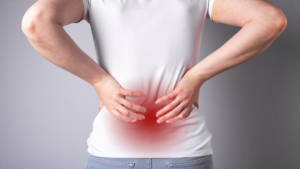
Treating Chronic Back Pain
Treating Chronic Back Pain
In many cases, chronic back pain is treated through the use of minimally invasive procedures and joint injections. Many physicians use fluoroscopic guidance to perform these types of treatments. This allows them to see the affected area on a display screen and precisely place the needle. Fluoroscopy guidance helps prevent surgery, since is allows minimally invasive techniques to be performed with the greatest accuracy.
Your individual symptoms, the source of pain, and need will determine the best treatment method. Many minimally invasive procedures and joint injections work to reduce pain.
Joint Injections and Treatment Options
Epidural Steroid Injections
This injection is used to reduce inflammation in the spinal column that causes pain and nerve irritation. An anti-inflammatory medication is injected into the epidural space in the spine. These injections are a good option for patients with spinal stenosis, herniated discs, and degenerative disc disease. Patients typically find their relief starts within a week of receiving the treatment and it lasts anywhere from a few days to a few months.
Facet Joint Injections
Facet joints are the small joints that allow your back to bend, twist, and move. When they become inflamed or injured, they can cause immense pain. This procedure injects a steroid and anesthetic medication into the joint. It can be very effective for patients who have suffered cartilage damage or back injuries from twisting. Pain relief may last weeks or months.
Trigger Point Injections
Trigger points are small muscle cramps within the body of a muscle that are extremely tender. Trigger points refer pain to other areas of the body. These injections administer a numbing agent to the trigger point, allowing it to relax and reduce pain. Trig point injections may be helpful if you experience back pain when pressure is applied in a specific area.
Sacroiliac Joint Block Injection
The SI joint connects the lower back of the spine to the pelvis. When the joints become inflamed and painful, movement can be affected and tasks such as sitting and walking. This injection consists of both an anti-inflammatory steroid and numbing agent. It is injected directly into the sacroiliac joint to relieve pain as effectively as possible.
Expected Results After Joint Injections
Joint injections are an outpatient procedure, and many times, they can be performed in your pain specialists’ office. Patients normally resume walking after the procedure, but need to have someone drive them home after receiving treatments. This is because doctors will administer a low-dose local anesthetic to numb the affected area before treatments.
Is is common for pain to continue a few days after the treatments, especially as the numbing agent wears off before the medication takes effect.
Pain relief generally starts two to seven days after the injection and can be reduced for several months. Your physician will often refer you to a physical therapist so you can exercise and strengthen your joints during this time of reduced or eliminated pain.
If injections prove to be helpful, the procedure can be repeated approximately 3 times a year. Other treatment options are available when joint injections do not reduce your pain. Keep track of your pain levels and communicate clearly with your doctor to create the best-suited treatment plan for your individual back pain.
The team of professionals at Progressive Pain Management are here to help. Fill out the form below to get started.
What is Spinal Stenosis?
The spine consists of bones called vertebrae. The job of these bones is to provide stability and support for the upper body. Nerves run through the openings in the vertebrae and transmit signals from the brain to the rest of the body. If the surrounding bones or tissues get damaged, it can affect basic movements like walking, balance, and sensation.
Spinal stenosis is a condition that causes the spinal column to narrow and compresses the spinal cord. This does not happen quickly, but is a more gradual concern. Too much narrowing compresses the nerves in the spinal and causes problems.
While aging is the most common cause of spinal stenosis, conditions like osteoarthritis and rheumatoid arthritis can contribute to the pressure on your spinal cord.
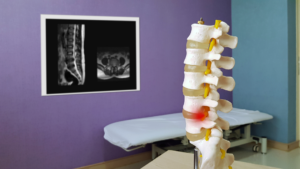
How is Spinal Stenosis Diagnosed?
What are the Symptoms?
Symptoms can vary depending on the location of the stenosis and the nerves that are affected. Since spinal stenosis is a gradual onset condition, the symptoms tend to start slowly and worsen over time. In fact, spinal stenosis may appear on an MRI or a CT scan without the patient having any symptoms at all.
Cervical Spine
- Numbness or tingling in the hand, arm, foot, or leg
- Difficulty walking or with balance
- Neck pain
- Bowel or bladder conditions such as urinary urgency or incontinence
Lumbar Spine
- Weakness in the foot or leg
- Pain or cramping in one or both legs after long periods of standing or walking
- Back pain
- Numbness or tingling in the leg or foot
How is Spinal Stenosis Diagnosed?
Your doctor will diagnose spinal stenosis by reviewing your medical history and perform a physical examination. They will also want to discuss any symptoms you experience. After a full review, your doctor may order several imaging tests to pinpoint the cause of symptoms and signs.
Imaging tests may include:
X-Rays
X-rays can determine if there was a bone change that could affect the spinal column, such as bone spurs.
Magnetic Resonance Imaging (MRI)
MRIs utilize a powerful magnet and cross-sectional radio waves to produce images of your spine. MRIs detect issues with ligaments and discs. It also has the ability to determine if there is a tumor pressing on the nerves. The most important reason why MRIs are helpful is that they are able to show where the nerves in the spinal cord are being compressed.
CT Scan
If you are unable to have an MRI, a CT scan may be used instead. This type of imaging test combines X-Ray images that are taken at many different angles to create a detailed, cross-sectional image of your body.
Get started on getting the relief you deserve by fill out the form below. The team at Progressive Pain Management is here to help you reduce pain and enhance your quality of life.
Degenerative disc disease (DDD) describes a group of symptoms that results from age-related wear-and-tear of the spinal discs. It could also be a result of an acute spinal injury that causes the spinal column to deteriorate or break down.
Despite its name, degenerative disc disease is, in fact, not a disease. This is a natural occurrence that is a result of aging. The rubber-like discs between the vertebrae that act like shock absorbers allow for bending and flexing of the back. Overtime, they become worn out and are unable to provide the highest level of protection. MRIs show some deterioration of the spine in the majority of patients over the age of 60.

How to Treat Degenerative Disc Disease
Symptoms of DDD
Symptoms are dependent on which disc is degenerated. The most common early sign is pain and weakness in the back that oftentimes radiates to another area. The pain can be weak to the point where it is almost nonexistent or very severe, preventing a person from continuing daily activities. Even if a person typically only has weak or dull pain, they may experience flare ups of extremely intense pain.
Pain may worsen throughout the day, due to bending, sitting, standing, and walking. Changing positions and continuing to move carefully can help prevent the pain from getting more intense.
The pain begins with damage in the spine, but overtime, the discomfort can result in other conditions such as osteoarthritis. Because the pain radiates to other areas of the body, people tend to feel pain and discomfort in their buttocks and upper thigh and tingling in the legs or feet.
When the degenerated disc is in the cervical spine, the neck area, the pain can radiate to the shoulder, arm, or hand.
Another symptom that is possible is for people to experience spinal instability, leading to muscle spasms in the lower back as the body tries to correct and stabilize the vertebrae. These spasms can be very painful.
Treatment Options for Degenerative Disc Disease
Treatment for degenerative disc disease generally begins with nonsurgical methods. Your doctor will determine the severity of the condition and recommend treatment methods based on your individual pain.
Nonsurgical Treatments Options
- Medications: Your physician may suggest taking NSAIDs or over-the-counter pain relievers such as aspirin or ibuprofen. These help inflammation that can ease your pain and lessen swelling.
- Physical Therapy: A physical therapist can help teach proper exercises to strengthen and stretch the correct muscles that help the back heal. Learning movement modifications to everyday tasks can help prevent painful flare-ups. Specific movements make the muscles in the neck and back stronger and more flexible, allowing better spinal support.
For most patients, physical therapy, in conjunction with pain medication, is enough long-term pain relief.
Surgical Treatment Options
If noninvasive treatment options do not work or if a person continues to experience severe pain, your physician may recommend surgery.
Surgery may include the removal of the degenerated disc, which is then replaced with a new disc. Another option is a partial disc removal (discectomy) to help relieve pressure from your nerves.
If there is a severe issue, your doctor may permanently connect (fuse) the bones in your spine after the disc is removed. This will reduce the movement in the damaged area.
Along with following your doctor’s treatment recommendations, self-care goes a long way in reducing pain and strengthening your spine. Physical activity and healthy lifestyle choices like a balanced diet, reducing mental and emotional stress, and stopping smoking have profound effects on this type of musculoskeletal condition.
If you have back pain or are suffering from degenerative disc disease, fill out the form below to get in touch wth the team at Progressive Pain Management.
Are you tired of dealing with back pain that just never goes away? The truth is, chronic back pain can be debilitating and difficult to manage. While many different treatments are available to help control your symptoms, radiofrequency lesioning may provide an effective solution.
Radiofrequency lesioning uses high-frequency electrical signals to deliver targeted heat directly to the source of your pain to create a small ablation or “lesion,” which can reduce discomfort for long-term relief. Keep reading to learn more about how radiofrequency lesions work, what they treat, and whether they are right for you.

Using Radiofrequency Lesioning to Treat Back Pain
What is Radiofrequency Lesioning?
Radiofrequency lesioning (RFL) is an invasive procedure to reduce chronic neck or back pain. During a radiofrequency ablation procedure, a doctor uses fluoroscopy (a live x-ray) to guide an electrode needle into the nerve that carries the pain signals from your spine to your brain. The electrode sends radio frequency energy through the needle, creating a small “lesion” that interrupts these painful nerve signals for long-term relief.
Using RFL for Back Pain
Radiofrequency lesioning is commonly used to treat a variety of chronic pain conditions, but it can be especially effective for treating lower back pain. If you have been struggling with chronic back pain, radiofrequency lesioning may be an effective treatment option. The procedure has been shown to reduce the intensity of pain-related symptoms and provide relief from stiffness and movement limitations in the affected areas. Talk to your doctor about whether radiofrequency lesioning is the right choice for you.
Benefits of Radiofrequency Lesioning
- It can provide long-term relief from back pain
- It is minimally invasive and typically requires only local anesthesia
- The procedure is quick – usually lasting around 30 minutes
- It offers the potential for a substantial reduction in the pain you experience
Is the Procedure Safe and How Does it Work?
Radiofrequency lesioning is generally considered a safe and effective treatment option for chronic back pain. Radiofrequency lesioning creates small nerve tissue lesions that interrupt pain signals from the spine to the brain. When these pain signals are blocked, they cannot reach the brain, and you experience long-term relief from your back pain.
The procedure typically requires only local anesthesia and takes about 30 minutes to complete. During radiofrequency lesioning, a doctor uses fluoroscopy (a live x-ray) to guide an electrode needle into the nerve that carries the pain signals from your spine to your brain. The electrode sends radio frequency energy through the needle, creating a small “lesion” that interrupts these painful nerve signals for long-term relief.
Risks of Radiofrequency Lesioning
Although radiofrequency lesioning is considered a safe and effective treatment option, some risks are still involved. These include bruising or bleeding at the injection site and temporary nerve damage that may cause numbness or tingling in the area around the lesion. There is also a small risk of infection associated with any medical procedure.
What can you expect from treatment?
The effects of radiofrequency lesioning vary from person to person. Some people may experience reduced pain immediately after the procedure, while others might take several days or weeks for full relief. Not all cases of chronic back pain can be cured with radiofrequency lesioning, and results may vary depending on the cause of your discomfort.
Get Treatment for Back Pain Today!
If you or someone you know is dealing with chronic back pain, don’t suffer any longer. Radiofrequency Lesioning may be the answer to finding relief. This minimally-invasive procedure uses radio waves to target and heat specific nerve endings, resulting in long-term numbing of the area.
Patients have reported a decrease in both pain and medication usage after having this procedure. Contact Progressive Pain Management to request an appointment!
Epidural steroid injections (ESI) are a minimally invasive procedure performed to help reduce inflammation and pain caused by nerve root compression. Herniated discs, bone spurs, or spinal stenosis cause nerve compressions. Pain, numbness, or weakness along the nerve are symptoms of nerve compression, referred to as radiculopathy. This pain can last for days or even years if left untreated.
An epidural steroid injection aims to help reduce inflammation along the nerve root. Medication is injected in the fat-filled area between the bone and the protective layer of the spinal nerve, called the epidural space. These injections are intended to reduce pain so that normal activity and a physical therapy program can be resumed.

What is an Epidural Steroid Injection
What is an Epidural Steroid Injection?
There are multiple types of steroid injections, most commonly described according to where they are injected. Steroid injections in the neck are called cervical epidural injections. Injections performed in the middle back are thoracic epidural steroid injections, and injections in the lower back are lumbar epidural injections.
The injections can also be labeled according to the direction of the needle. Most epidural steroid injections are placed between the lamina. This is called an interlaminar epidural steroid injection. The needle is aimed upwards toward the head and goes in between two laminae. Another type of injection is a transforaminal steroid injection. The needle travels along the course of a nerve and enters the spine from a diagonal direction. A caudal approach to ESIs allows the needle to enter directly into the epidural space through the sacral hiatus – a small boney opening directly above the tailbone.
The steroid injection contains a corticosteroid, such as triamcinolone, methyl-prednisolone, or dexamethasone, and an anesthetic numbing agent like lidocaine. They are injected into the area between the vertebra and the protective sac surrounding the spinal cord and nerves.
Why Are They Used?
These steroid injections are used in patients who suffer from pain in the neck, arm, lower back, or have sciatica. This treatment has proven beneficial to those with severe inflammatory conditions. Patients who have the following conditions are candidates for epidural steroid injections:
- Spinal Stenosis – a narrowing of the spinal canal and nerve root canal
- Herniated Disc – the material inside a disc can bulge or rupture through a weak area in the cartilage and come in contact with a spinal nerve.
- Degenerative Disc – breakdown or aging of a spinal disc causing the disc space to collapse or growth of bone spurs.
- Sciatica – compression of nerves that causes pain to travel into the buttocks and down the legs.
In some cases, ESI can be used to determine whether surgery will be successful in patients who have a herniated disc. The injections can ease pain enough so a physical therapy routine can be established.
Risks Involved with Epidural Steroid Injections
ESI procedures have been performed for many years and is considered a safe and effective treatment. Although uncommon, some patients do experience side effects from the medication. Patients may experience a “steroid flush” which is a flushing of the face and chest that can be accompanied by a low-grade fever.
Other side effects may include:
- Trouble sleeping
- Temporary water retention
- Anxiety
Serious complications are very rare, but could include an allergic reaction to the contrast dye, infection, nerve damage, or bleeding. When this procedure is performed with fluoroscopic guidance, the risk is minimized. Generally, this type of procedure and injection is very well tolerated by most patients.
To learn more about epidural steroid injections and how they can help back pain, fill out the form below:

